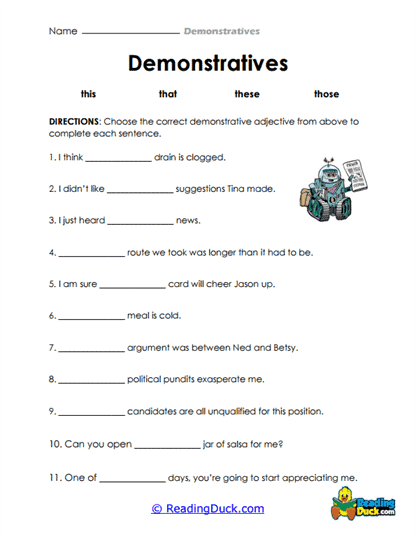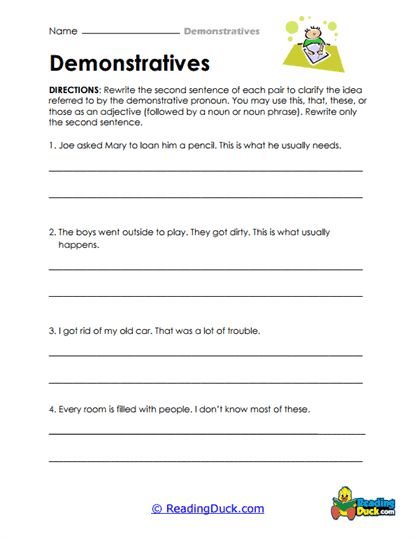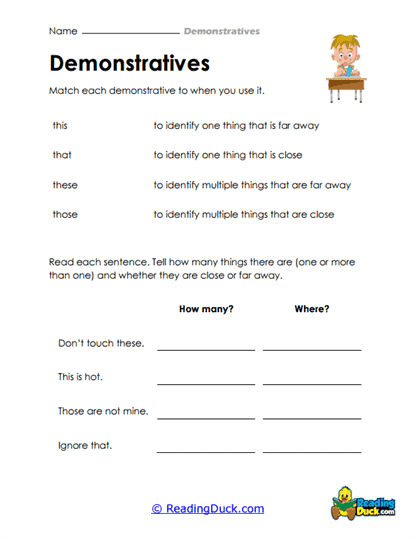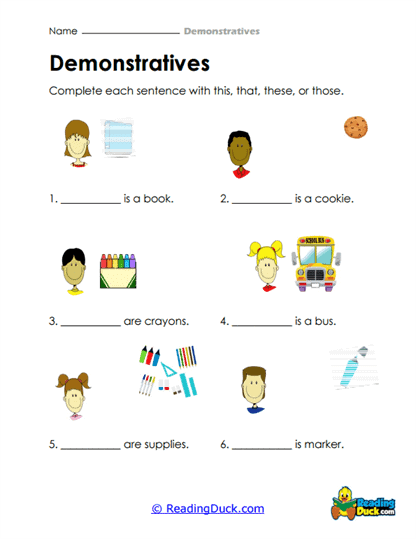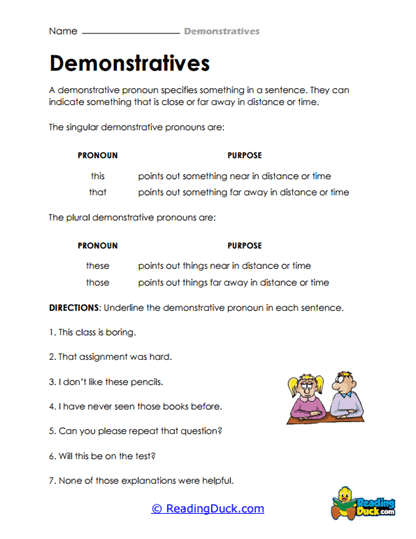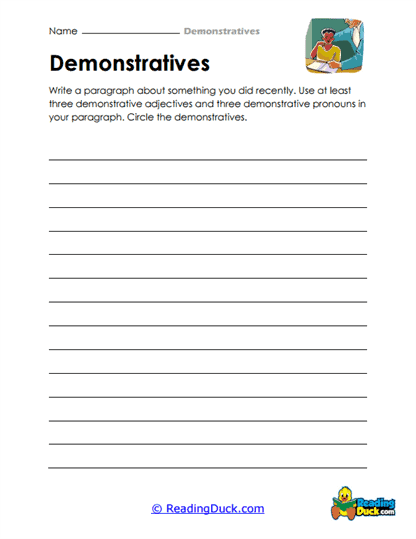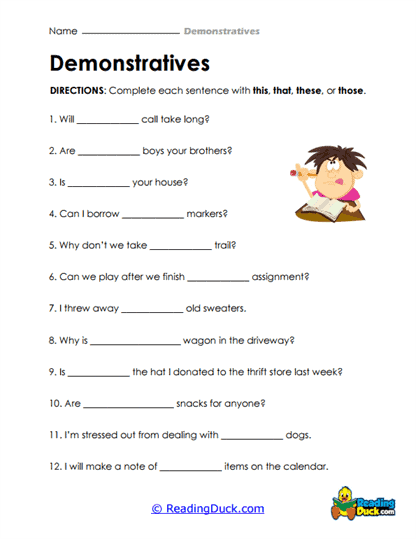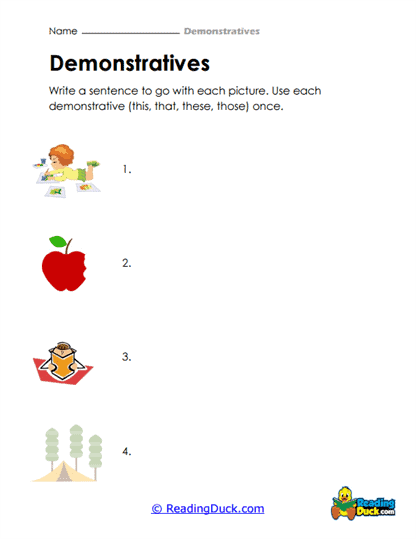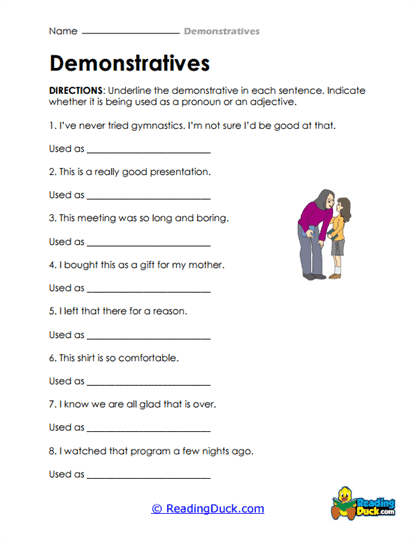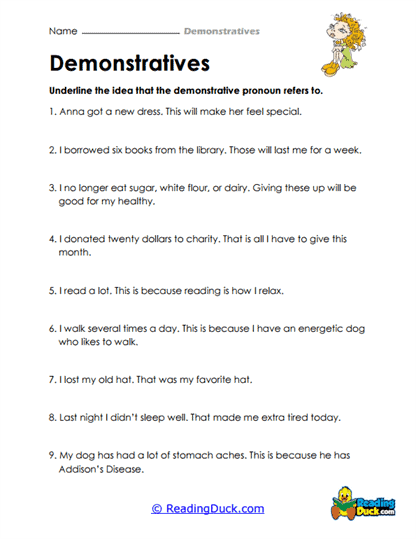Demonstratives Worksheets
About Our Demonstratives Worksheets
Our Demonstratives Worksheets collection is specifically designed to enhance students' understanding of one of the most essential grammar concepts: demonstratives. As part of the Grammar category within the Skills section, these worksheets focus on helping students identify, use, and differentiate between the demonstrative pronouns and adjectives in English. Demonstratives are frequently used in everyday communication, so developing a solid grasp of them is vital for effective language use.
These worksheets break down the topic into clear, manageable sections that build from basic to more advanced uses of demonstratives, guiding students as they progress in their understanding. By engaging with a variety of activities, students will practice applying demonstratives in different contexts, improving both their written and verbal communication skills. The worksheets are offered in PDF format, making them easy to view, download, and print. Additionally, each worksheet comes with a downloadable answer key, ensuring that both educators and learners can assess progress and understanding with ease.
Understanding Demonstratives: A Detailed Overview
Demonstratives are an essential component of English grammar that help indicate or point out specific people, places, or things. They clarify spatial and temporal relationships, and are crucial for providing context in sentences. Demonstratives consist of four main words: this, that, these, and those. These words can act either as pronouns or as adjectives, depending on how they are used in a sentence.
Definition of Demonstratives:
Demonstratives are words used to indicate or “point to” specific nouns based on their proximity to the speaker, either in terms of physical distance or in time. In English, the four primary demonstratives are this and these (which refer to things that are close to the speaker) and that and those (which refer to things farther away from the speaker).
Types of Demonstratives:
Demonstrative Pronouns:
- Demonstrative pronouns replace a noun that is either nearby or far from the speaker, allowing for more concise language. For example:
This refers to a singular noun that is close to the speaker.
These refers to plural nouns that are close to the speaker.
That refers to a singular noun that is farther away.
Those refers to plural nouns that are farther away.
- Examples:
"This is my favorite book." (close, singular)
"Those are beautiful flowers." (far, plural)
Demonstrative Adjectives:
- Demonstrative adjectives modify a noun by specifying which one(s) the speaker is referring to. Like demonstrative pronouns, these also indicate proximity.
This book (close, singular)
These shoes (close, plural)
That car (far, singular)
Those houses (far, plural)
- Examples:
"I love this sweater." (The speaker is indicating a specific sweater that is nearby.)
"Those cookies look delicious." (The cookies are farther away from the speaker.)
Demonstratives and Proximity:
- Demonstratives express two dimensions of proximity:
Near the speaker: This (singular) and These (plural)
Far from the speaker: That (singular) and Those (plural)
Temporal Use of Demonstratives:
- In addition to spatial proximity, demonstratives can also indicate time:
"This year has been challenging." (This refers to the current year, near in time.)
"That day was unforgettable." (That refers to a specific day in the past, distant in time.)
By understanding both spatial and temporal applications of demonstratives, students can communicate more precisely and naturally in English. Recognizing when to use each demonstrative based on context is a fundamental skill in mastering English grammar.
Effective Approaches to Teaching Demonstratives
Introducing the concept of demonstratives to students requires a step-by-step approach that builds from simple to more complex applications. Several strategies can help educators guide their students toward mastery.
- Use Real-Life Objects: Start by introducing the concept using physical objects in the classroom. Hold up an object nearby and say, "This is a pencil." Then point to an object across the room and say, "That is a chair." By demonstrating the distance difference, students can visualize the relationship between the demonstratives and the objects they describe.
- Incorporate Visuals: Use pictures or diagrams to represent items that are either close or far away. For example, show a picture of a person holding a phone (close) and another person pointing to a distant car (far). This visual aid helps students connect demonstratives to their spatial meanings.
- Model Sentences: Provide model sentences that demonstrate the correct use of demonstratives in both singular and plural forms. Let students repeat after the teacher, which allows them to hear and practice the difference between this/these and that/those.
- Interactive Dialogues: Pair students up for a dialogue activity where they use demonstratives to describe objects around the room. One student could say, "Look at this pencil!" while the other responds, "Can you see that clock over there?" This encourages active use of demonstratives in conversation.
By starting with concrete examples and gradually moving toward more abstract uses of demonstratives, educators can ensure that students build a strong foundation in this topic.
Common Challenges and Solutions for Learning Demonstratives
Although demonstratives may seem simple, students often face several challenges when learning how to use them correctly. These challenges can stem from confusion about spatial relationships or misunderstanding the use of singular versus plural forms.
Challenge: Confusing Singular and Plural Forms
-
- Many students may struggle to distinguish between this/that (singular) and these/those (plural), especially when used with objects that seem similar in number.
- Strategy: Use practice exercises that emphasize the difference between singular and plural forms. Provide example sentences with blanks for students to fill in with the correct demonstrative based on context.
- Example: "____ (These/This) books are mine." Encourage students to explain why these is correct for plural items.
Challenge: Mixing Up Proximity
-
- Another common challenge is mixing up which demonstratives indicate closeness versus distance. For example, students might use that to refer to something near them.
- Strategy: Create simple spatial scenarios where students can practice distinguishing between near and far objects. For instance, place a book on their desk and another across the room, asking them to correctly describe each one using this and that.
Challenge: Overgeneralizing Demonstratives
-
- Some students may overuse one demonstrative, such as always using this or that, regardless of the noun’s proximity or number.
- Strategy: Reinforce variety in sentence-building exercises by providing a mix of both near and far, singular and plural nouns. Ask students to create their own sentences that correctly use all four demonstratives in different contexts.
Creative Activities to Reinforce Demonstratives
To help students retain and master the use of demonstratives, educators can integrate a variety of engaging and interactive activities. These activities can be adapted for both classroom and homeschool environments and are suitable for a range of grade levels.
- Demonstrative Scavenger Hunt (Grades 1-3): Organize a scavenger hunt where students must find objects around the room and describe them using demonstratives. For example, they could write down, "This is a chair" or "Those are windows." This activity encourages students to apply what they’ve learned in a real-world context.
- Matching Game (Grades 2-4): Create a matching game where students pair demonstrative pronouns or adjectives with the appropriate noun. For instance, one card might say "that" and another might have a picture of a distant object. Students must find the correct pair, reinforcing their understanding of demonstratives and proximity.
- Story Writing Challenge (Grades 3-5): Have students write short stories where they must incorporate all four demonstratives in various contexts. Encourage creativity by asking them to set their story in different places (e.g., in a room, outside, or in the past) so they can practice both spatial and temporal use of demonstratives.
- Group Discussions (Grades 3-6): In group discussions, ask students to describe various objects in the classroom or around them. Encourage them to pay attention to distance and number, using demonstratives correctly in their responses. This activity works well in both in-person and online settings, helping students practice speaking and listening skills.
The Importance of Learning Demonstratives
Demonstratives are a fundamental part of communication, allowing speakers and writers to clarify which specific person, place, or thing they are referring to. Understanding how to use demonstratives enhances a student's ability to provide clear, concise descriptions and instructions. Whether students are writing essays, giving presentations, or simply having everyday conversations, a solid grasp of demonstratives allows them to communicate with precision.
By mastering this concept through our Demonstratives Worksheets, students gain a crucial tool for both academic success and real-world communication. The ability to use this, that, these, and those correctly allows students to build more complex sentences, express spatial and temporal relationships clearly, and enhance their overall fluency in English.
